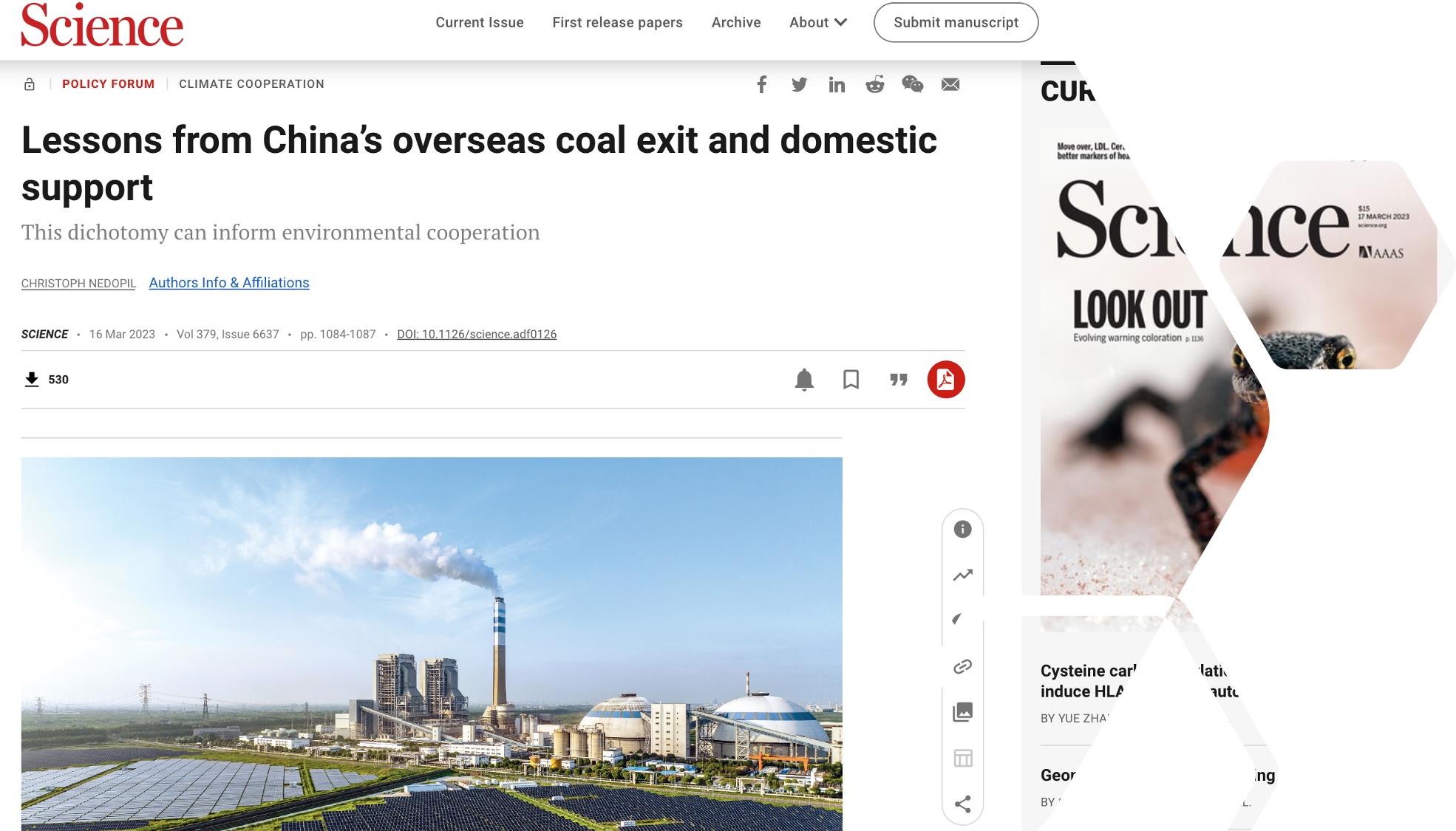The text is based on an article published in Science on March 16, 2023 by the author. More information, including a copy of the paper, can be found online here.
The reduction of environmental risks, such as climate change and biodiversity loss, is a challenge requiring global cooperation. It is a challenge that cannot succeed without active support from China. Domestically, China has become the world’s greatest source of GHG emissions and exhibits high vulnerability of its biological diversity. Meanwhile, internationally, China’s influence through trade, finance, and investment – not least through its Belt and Road Initiative (BRI) – is among the biggest in the world with severe biodiversity and climate implications.
China achieved an important climate milestone in September 2021 when China’s President Xi unilaterally announced to stop building new coal fired power plants abroad. Some believe that this decision was driven by international pressure, e.g., by the EU, the US, or G7. Yet, this notion seems incomplete and risks misguiding countries’ environmental cooperation strategies with China.
In contrast to China’s overseas coal exit announcement, China accelerated approvals of new domestic coal plants in 2022 to 106 GW, the highest number since 2015. In a new study published in the Science, a globally leading academic journal, an analysis of this “Panda-Dragon” dichotomy of China’s domestic and international coal strategy provides new insights into Chinese environmental policy making and potential cooperation strategies.
The study finds several reasons that drove China’s decision to exit overseas coal (while admitting that loopholes exist). First, the coal exit decision was enabled by strong cooperation among select Chinese and international partners, including the Belt and Road Initiative International Green Development Coalition (BRIGC) under the Ministry of Ecology and Environment (MEE). The BRIGC works with Chinese and international partners to better develop and integrate green development standards in the BRI. In December 2020, ten months before the official coal exit announcement, BRIGC supported the Green Development Guidance for BRI projects that labelled coal-related projects as “red” or restricted. Following this “traffic light system” publication, BRIGC completed a special research report recommending a coal exit that “firmly underpinned the decision-making on China’s overseas coal-related investments”, according to BRIGC. A most important factor contributing to the exit decision was that host countries of Chinese coal fired power plants, many of which are BRI countries, changed their interest in coal-fired power plants. Reasons for this “change of heart” included economic considerations, such as the increasing price of coal compared to decreasing cost for renewables, social reasons, such as demonstrations against coal plants like against Kenya’s Lamu coal-fired power plant, and lower than expected power demands during COVID.
The study also finds that China seems to find value in promoting its environmental ambitions in neutral, multilateral forums, particularly the United Nations. Compared to an announcement at a climate summit, such as the climate COP, where such announcements could be seen as the result of intense negotiations and bargaining between the parties, the UN forum allows China to present the decisions as free from international pressure. It allows China to gain global recognition or “green soft power”.
The continuous and expanded domestic coal support, meanwhile, seems to be similarly driven by various factors. Most recently, Chinese planners seem to believe that coal will provide better energy security and energy independence (China imports about 10% of its coal, and imports about twice as much coal as the second biggest importer India). A complex stakeholder landscape in China is also interested in further supporting coal. Such stakeholders include domestic political leaders, financial institutions, and state-owned enterprises along the whole supply chain (including in mining) and in different provinces that have strong dependence on coal. Coal in China supports millions of workers which makes a coal exit politically and socially risky. Thus, rather than phasing down coal to reduce greenhouse gas emissions more rapidly, China embarks on the dual strategy to expand support for both coal and renewables to provide electricity.
This panda-dragon approach between China’s domestic and overseas coal engagement also sheds light on how international cooperation strategies on environment can succeed if they are tailored to China’s needs. Importantly, cooperation on international topics, such as in China’s BRI, can be successful if Chinese institutions, such as BRIGC, are supportive. International cooperation can also support host countries to accelerate demand for green over “red” projects. This can also include financial support by Chinese and international partners to reduce the financing cost for green projects – and similarly to increase costs for developers for environmentally harmful projects. Cooperation on China’s domestic issues, meanwhile, requires a much better understanding of sensitivities regarding environmental versus political and economic risk perceptions within China. Any cooperation requires continuous trust building, for example through research collaborations and cooperation in specific sectors that China sees as strategic green growth areas, such as green finance. Finally, adding political pressure on China to become greener seems often counterproductive, while international partners can improve cooperation results by showing genuine interest for China’s existing green successes.
Some international organizations have already successfully adjusted their strategies to work with China on domestic and international environmental outcomes. As the protection of global climate and biodiversity cannot succeed without China, more, not less such cooperation seems necessary.
Dr. Christoph NEDOPIL WANG is the Founding Director of the Green Finance & Development Center and a Visiting Professor at the Fanhai International School of Finance (FISF) at Fudan University in Shanghai, China. He is also the Director of the Griffith Asia Institute and a Professor at Griffith University.
Christoph is a member of the Belt and Road Initiative Green Coalition (BRIGC) of the Chinese Ministry of Ecology and Environment. He has contributed to policies and provided research/consulting amongst others for the China Council for International Cooperation on Environment and Development (CCICED), the Ministry of Commerce, various private and multilateral finance institutions (e.g. ADB, IFC, as well as multilateral institutions (e.g. UNDP, UNESCAP) and international governments.
Christoph holds a master of engineering from the Technical University Berlin, a master of public administration from Harvard Kennedy School, as well as a PhD in Economics. He has extensive experience in finance, sustainability, innovation, and infrastructure, having worked for the International Finance Corporation (IFC) for almost 10 years and being a Director for the Sino-German Sustainable Transport Project with the German Cooperation Agency GIZ in Beijing.
He has authored books, articles and reports, including UNDP's SDG Finance Taxonomy, IFC's “Navigating through Crises” and “Corporate Governance - Handbook for Board Directors”, and multiple academic papers on capital flows, sustainability and international development.





Comments are closed.